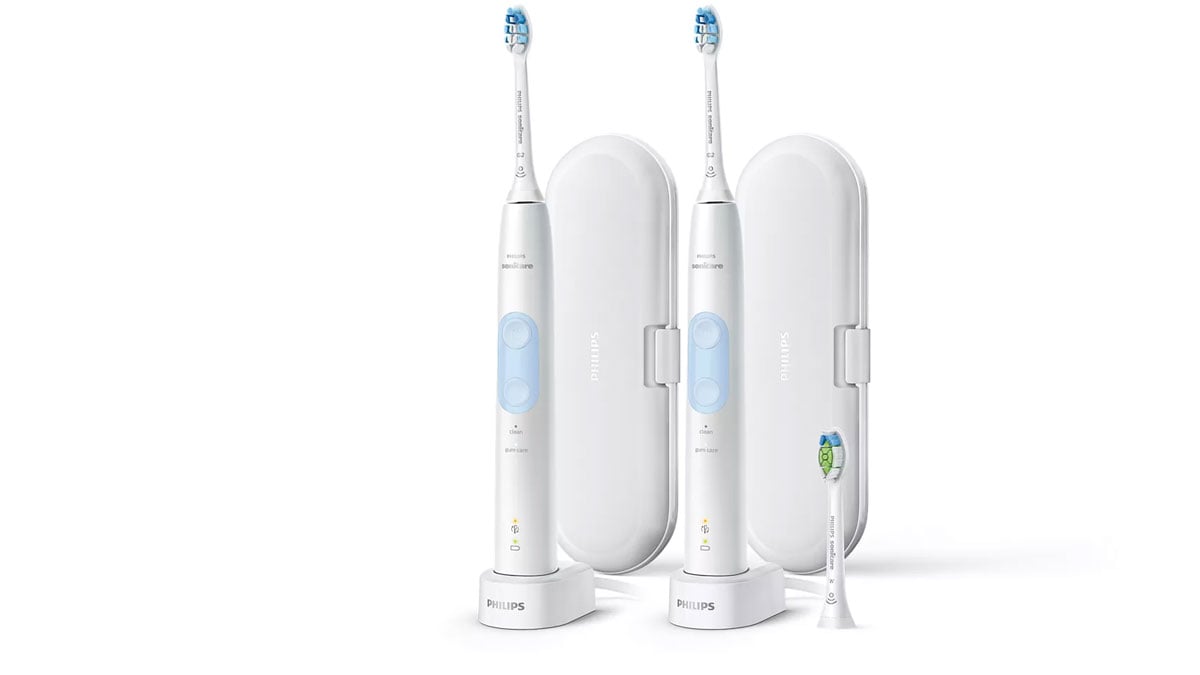
A great package for couples wanting their own brush
The Sonicare Optimal Clean (sometimes referred to as the ProtectiveClean) offers a great clean of the teeth and has all the essential features you require built-in.
It is really as close to perfect as you are going to get, particularly when it is supplied as a bundle that includes 2 x handles, travel cases and charging stands.
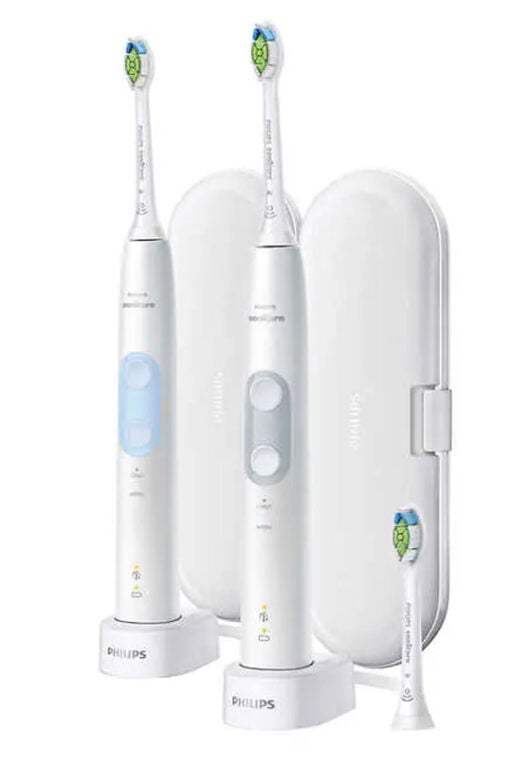
Pros |
Cons |
|---|---|

Reminds you when to replace the brush head |
Not as widely stocked as other brushes |

Long battery life |
|

2 cleaning modes to suit your needs |
|

2 travel cases & charging stands |
Consider these other brushes
If you want a dual handle package, the Optimal Clean is a great option. And quite frankly, providing the price is acceptable, there is little point in considering alternatives.
But, it's always worth seeing what else is on offer and models like the 4100 Series or the 5100 ProtectiveClean should be considered.
The 4100 will likely be cheapest, but doesn't come with a travel case.

Design, usability, clean & general use
Sonicare has a long history of electric toothbrushes and I've never been truly disappointed by one of their products. Some are of course better than others, but all do a pretty decent job and the Optimal Clean really should be no exception.
Although named Optimal Clean the handle design and features are most similar to a more widely stocked range called ‘ProtectiveClean’ which I am a fan of.
It is worth a quick mention here that Sonicare does a pretty decent job on their packaging. Let’s be honest, an electric toothbrush is not the best for the environment, so it's great to see that cardboard box and inner trays are recyclable.
Out of the box the Optimal Clean looks and feels good in the hand and I think it is fair to say that the handles actually give a sense of quality that exceeds the price asked of them and what you might expect.
Taking a closer look at the Optimal Clean brush handle then.
Primarily all white in color the handle has a matt finish, so although a little clinical looking it is not as harsh as the gloss white colors seen on some other toothbrushes.
The main color accent is around the power and mode button on the front of the handle.
An ovalish panel, it is light blue in color with a slight gloss finish to the plastic. It contrasts nicely with the white of the handle.
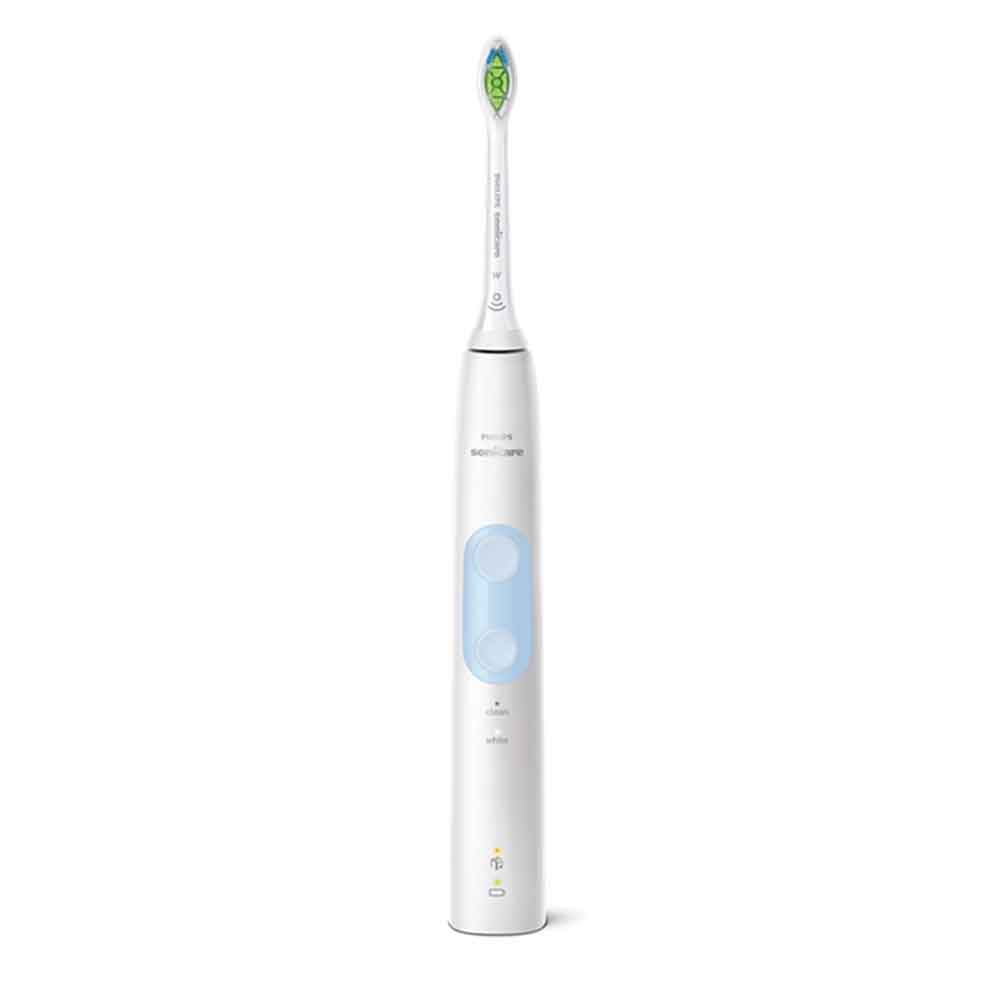
The 2 buttons placed a little above the halfway point on the handle, both have a concave design to them.
Embossed into the top power button is a power icon, while the lower button is smooth to the touch. Both are coated in a silicon material so softer to the touch and a bit grippy. Both buttons provide a reassuring feedback and are not too soft or firm to the touch.
Above these buttons is the Philips Sonicare logo printed on the handle in a grey color.
Below are 2 LED’s stacked on top of each other, with the name of the cleaning modes in between.
Each LED is lit when the cleaning mode is selected.
The brushing mode can be changed via the lower mode button on the handle.
It is of course the power button that turns the brush on and off.
Right towards the bottom of the brush handle are a further 2 LEDs and icons.
First sits the BrushSync LED and symbol, more on this shortly, and below that, the battery LED and symbol
The LED for the rechargeable battery, that lasts 2+ weeks, lights up and flashes in a few different ways. Check out the ‘Battery Life’ section of this review for more information on that.
Rounded in its design the handle is not too large or too small.
The back of the handle is smooth to the touch. No ridges or extra grips, with the exception of a little protrusion at the bottom of the handle.
It seems a bit out of place and not immediately obvious what it is for. But, lay the brush on a flat surface, and this raised molding stops the brush rolling about. Genius!
The base of the brush is flat with the exception of a recess into which the prong on the charging stand fits. The brush will sit upright on a flat surface and does too sit upright on the charging stand.
At the top of the brush handle is the metal shaft that the brush head connects to. This metal shaft feeds into the motor sealed inside the handle.
Analyze the brush side on and you will see how the brush head fits on at a very slight angle.
Slight it might well be, but it helps angle the brush head for a better reach towards the back of the mouth. A subtle, but important design feature that enhances the overall usability.
In the box with the Optimal Clean you get 3 brush heads. 3 seems like a strange number given you have 2 handles. Surely 2 or 4 would make more sense?!
Irrespective, all 3 are the W DiamondClean (also known as W2 Optimal White) brush heads.
This is just 1 style, from a range of interchangeable brush heads that Sonicare offer. We cover brush heads in more detail in our guide to Sonicare brush heads.
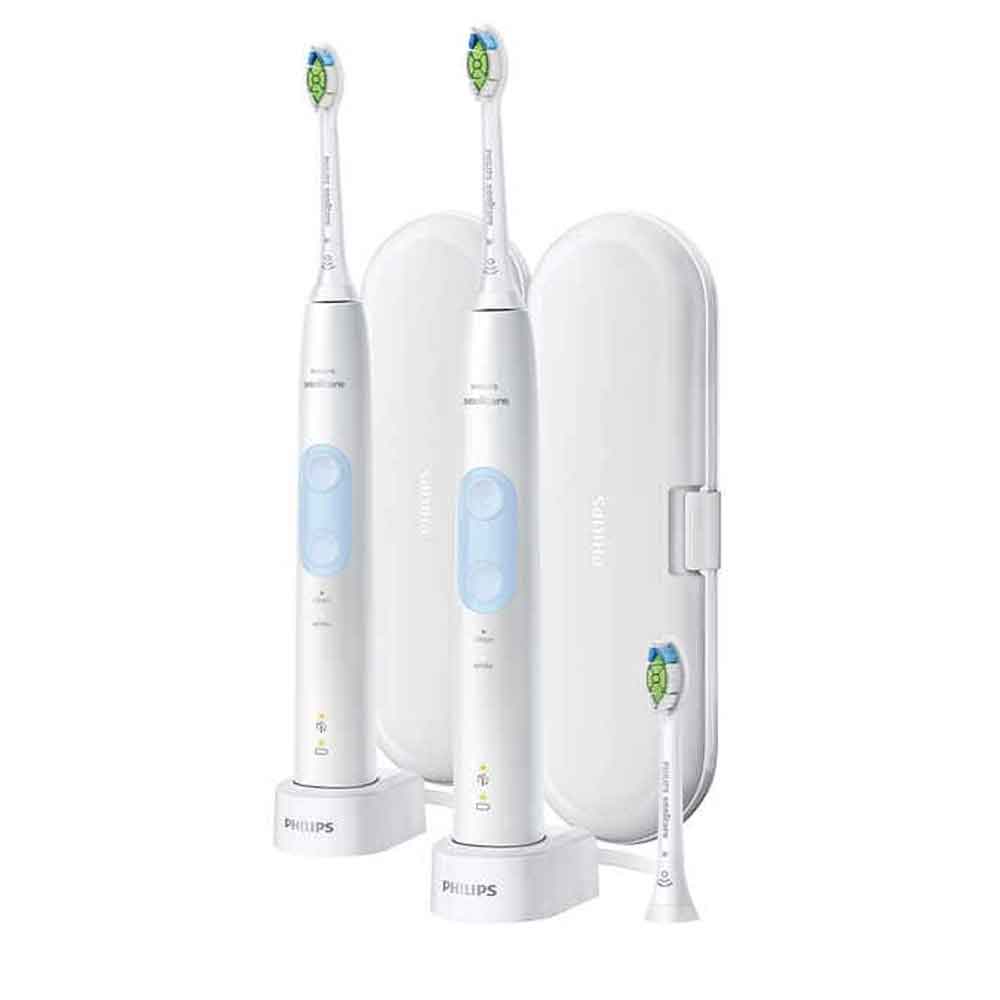
Fitting the brush head is a simple process
Each brush head simply pushes on and pulls off of the brush handle. The heads fit over the metal shaft at the top. You can usually feel it clip into place.
Almost all brush heads are interchangeable and work on almost all Sonicare brush handles, so you can find the brush head that works for you or that you prefer and use it on your brush handle.
But, with the Optimal Clean handles there is something you need to be aware of.
They have a feature called ‘BrushSync’. What this does is tells you, via an LED on the brush handle (the one I mentioned earlier - picture of a brush head)) when it is time to change or replace your brush head.
You see, inside the brush head supplied is a small microchip.
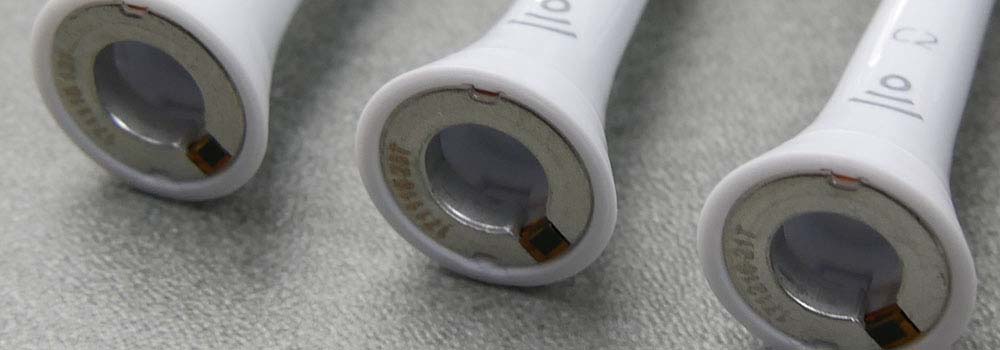
When the brush head is fitted to the brush handle, the chip is detected and the warning light will flash 3 times. This acts as confirmation that the handle has detected the head and that the electronics inside the handle will now keep track of it.
As you use the brush head, the handle continues to track how often it has been used.
The handle knows that the brush head should be replaced every 3 months, so once the handle detects that the brush head has been used for this amount of time, the ‘BrushSync’ LED on the brush handle will light up an amber/orange color. It is at this point you should fit a new head.
But, the brush is cleverer still.
If it detects you have brushed 3 times a day every day or brushed with more pressure, it will activate the BrushSync alert system sooner, as the bristles will have worn out sooner than the typical 3 month time period.
By the same token, it will delay alerting you to replace the brush head. If you used that head just once a day over 3 months, it would not tell you to replace it until it had been used for an equivalent to 4 minutes a day for 3 months.
Hard not to be impressed!
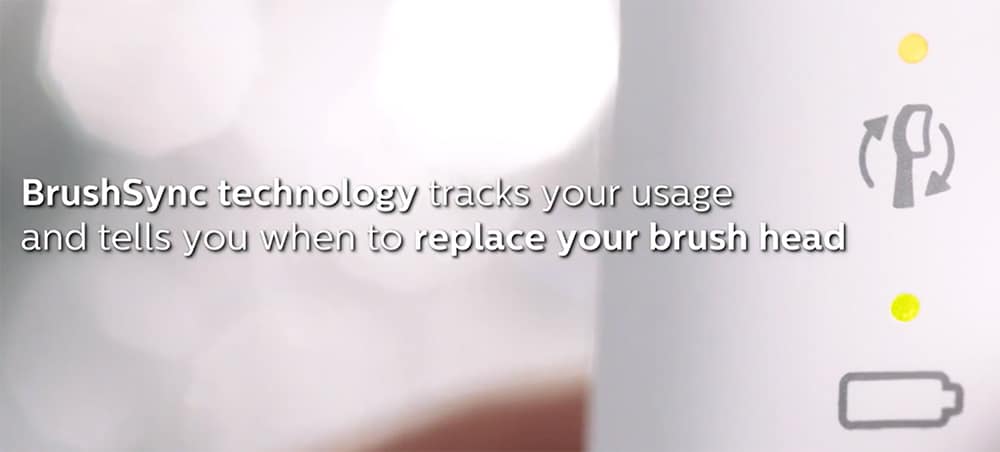
Using a brush head for longer than 3 months can potentially have negative effects on the teeth and gums, so such an alert helps reduce the chances of this.
Technology such as Bluetooth connectivity found on some brushes is not for everyone. Not all that many see the point, but I think most people see the point here.
The sensors are smart, unobtrusive and are only trying to help you take better care of your teeth and gums.
There is something you need to be aware of.
Whilst the vast majority do, not all the brush heads Sonicare make have the microchip built-in.
So for it to work, both the brush head and brush handle have to have the ‘BrushSync’ feature. Those heads without the chip inside will work with the Optimal Clean 5000 series, but you won’t get the reminder when it is time to replace them. Just be aware of this when buying replacements. Our guide to Sonicare brush heads goes into more detail about this.
But for a little extra peace of mind, all Sonicare brush heads have fading indicator bristles.
As the heads are used, the Blue bristles fade to a very pale almost white/translucent color. When they are this color, it is time to change the head.
It is like a simplified alternative to BrushSync.
The brush heads are not the only clever part of this electric toothbrush.
Essential to any good brush in my opinion, is a timer and quadpacer. Both are included as standard with the Optimal Clean.
A simple press on the power button will turn the brush on. As the motor is kicked into life, the timer is too.
Using the standard ‘Clean’ mode the timer runs for 2 minutes, which is the dentist recommended cleaning time.
The 'White' mode runs for 2 minutes and 30 seconds.
At the end of either mode the brush actually turns itself off.
At the same time, the timer begins working, as does the 30 second timer or quadpacer as it is known.
During the standard cleaning cycle, at 30 second intervals, the brush motor pauses briefly.
This stops the cleaning action and pauses the humming sound and vibration from the handle.
It is this pause that alerts you to the fact that it is time to change quadrant.
Whilst dentists recommend 2 minutes of cleaning twice a day, what this does not help with is ensuring you and I brush our teeth evenly. This is where the pacer comes in.
The idea is that you break the mouth up into 4 sections. Upper right, upper left, lower right, and lower left.
You spend 30 seconds cleaning each section, that way over the 120 seconds (2 minutes) of brushing time, you will give a relatively even clean to the teeth and gums.
As you get the pacer alert, you change quadrant to in turn achieve the even clean.
Of course, you don’t have to follow it, but it is good practice.
Spending 2 minutes cleaning just the front teeth or just your top teeth is better than nothing but isn’t great for your oral health.
Therefore the 2 minute timer and 30 second pacer are 2 excellent additions to this handle.
If you use the 'White' mode, the pacer still functions for the first 2 minutes of cleaning only. The remaining 30 seconds are for focusing on the front teeth only, to help buff them to a nice shine.

If it was not already clear, the 2 brushing modes provided on the Optimal Clean handles are:
- Clean mode
- A 2-minute mode. It gives you a thorough and complete clean.
- White mode
- A 2-minute 30-seconds mode. 2 minutes for normal cleaning and 30 seconds to polish the front teeth.
Press the cleaning mode button to cycle through the modes, until you get to the mode you want.
The LED for the cleaning mode lights up as it is selected.
The mode can be changed before the brush is switched on.
The brush will remember the last cleaning mode used and begin in that mode the next time the brush is powered on.
With any mode, it is important to use the toothbrush correctly to get the maximum benefits.
You should not move the brush head back and forth in a rapid manner as you might with a manual brush, the motor in the Optimal Clean does this. You move the head from tooth to tooth, the motor and bristles does the majority of the work.
You should hold the brush head at a 45 degree angle to the teeth and gumline.
Our in house dentist recommends then moving the brush in small circular motions to get the maximum cleaning effect.
Irrespective of the cleaning mode used, I have been very impressed with the results and overall performance of this brush.
At no point have I felt the clean to be bad and certainly comparable to Oral-B.
There is clinical evidence that sides with both brands, but the reality of the situation is either are very good.
Personally I prefer the smaller, round brush heads that Oral-B offer compared to the larger, more rectangular/ovalish heads of Sonicare. I find them easier to move around the back teeth.
Another point to note, is that when brushing the teeth, the bristles need only skim the surface of the teeth to dislodge bacteria, plaque, and food debris, lots of force is not required to brush the teeth clean.
Brushing too hard over long periods of time can wear out brush heads but also cause gum recession and damage to the tooth enamel.
To help prevent this, the Optimal Clean has a pressure sensor built-in.
The handle vibrates to alert you when too much pressure is being applied, the brushing sensation and sound changes too.
The BrushSync replacement reminder LED flashes amber when the sensor is activated. Given its position, it is not the easiest to see.
It does not have the large visible pressure sensors as found on many Oral-B models.
Reduce the pressure applied to stop the pressure sensor from being activated. The sensor will kick in every time too much pressure is applied.
Seasoned electric toothbrush users may know how much pressure is appropriate. I believe it is more useful to first time or new users, but I am sure there are some electric toothbrush uses that brush too hard.
Within a few days, you will get used to how much pressure is appropriate.
Another great feature is something known as EasyStart.
This is a system that gently increases the power over the first 14 brushings to help you get used to brushing with the Optimal Clean brush.
A simple, but innovative touch that shows an extra level of attention and care for first time electric toothbrush users. The full 62,000 movements per minute can seem quite intense on first use. EasyStart eases you in and makes the transition from manual to electric brushing easier.
Of course a toothbrush will come into contact with water and the Optimal Clean handles are water resistant. They are not waterproof and it is advised not to use when bathing.
The handle feels robust and will generally take a few knocks in its life and I have no immediate concerns about the handle's reliability.
Sonicare does offer a 2 year warranty that covers any mechanical or workmanship faults, but not user damage.
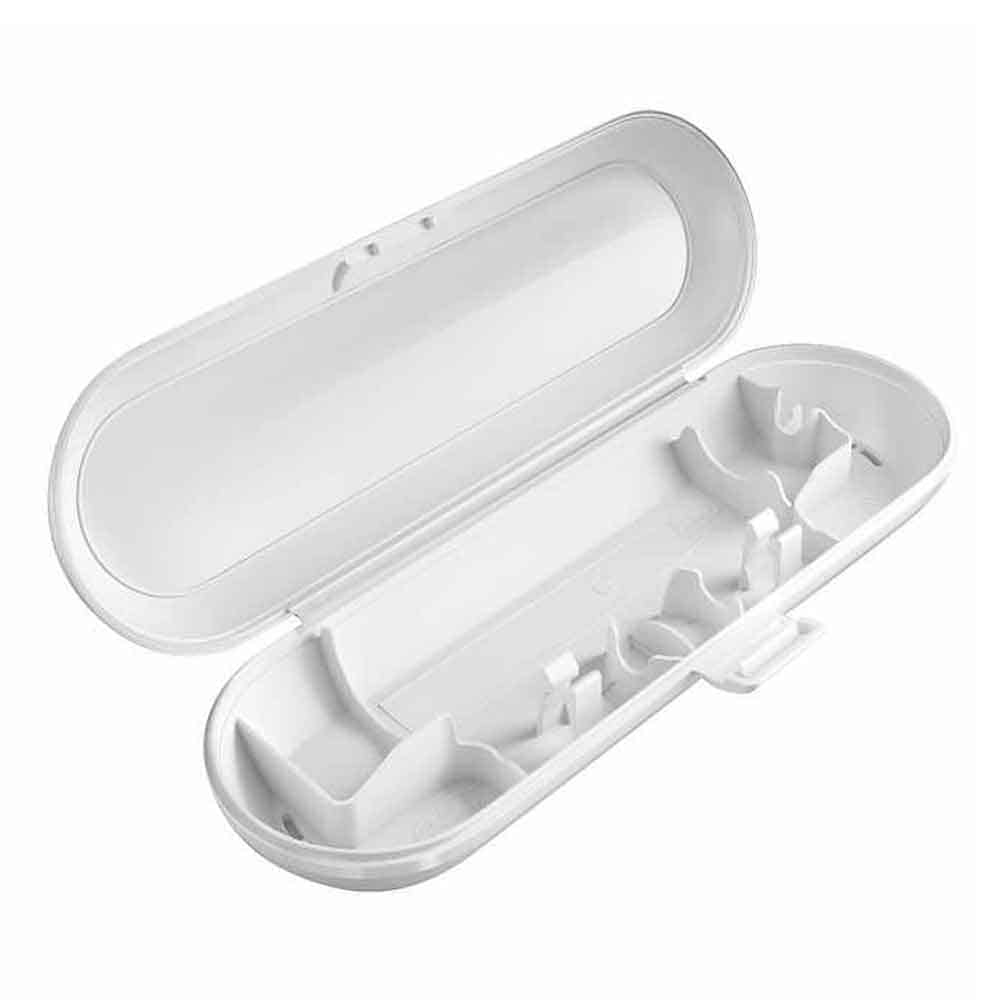
And then rounding off the package that is on offer here is a travel case. Or should I say 2 travel cases, 1 for each handle.
Made from a thick plastic, each case is hinged on the left side with a clip on the right to securely fasten it shut.
The case holds a single Optimal Clean lbrush handle and up to 2 brush heads.
Not only will it stop the handle or heads getting damaged, it also stops any accidental activation of the brush.
Sonicare has done a great job here. Whether you are a new or existing electric toothbrush user you will be impressed.
Summary of design, usability, clean & general use
Battery life
In my experience, the vast majority of Sonicare toothbrushes outperform the claimed battery life.
Precise usage time can vary depending on the cleaning mode selected and the total amount of time you spend brushing.
The 'Clean' mode on the Optimal Clean lasts for 2 minutes, but 'White' mode lasts for 2 minutes 30 seconds.
Built into the handle of the Optimal Clean is a rechargeable Lithium-Ion battery. It is not user removable.
The claimed battery life is 2 weeks but my own hands-on testing achieved a staggering 37 days, or 5 weeks with the 'Clean' mode.
You see what I mean about exceeding the expectations and outperforming.
Compare this to Oral-B and on the face of it, they seem quite comparable, because most Oral-B models now have a claimed 2 week battery life.
But, in actual use the Oral-B models really do only last 2 weeks and do not exceed the claimed life in the way that Sonicare brushes do.
For the vast majority of us a couple of weeks use on a single charge is perfectly sufficient. Most of the time we are at home and are able to recharge the battery when it is required.
However, it is nice to know that you can go away on vacation or for business and not need to worry about taking the charger with you.
When the battery is in need of a recharged, you can use the charging stands that are provided in the box. You get 2, 1 for each handle.
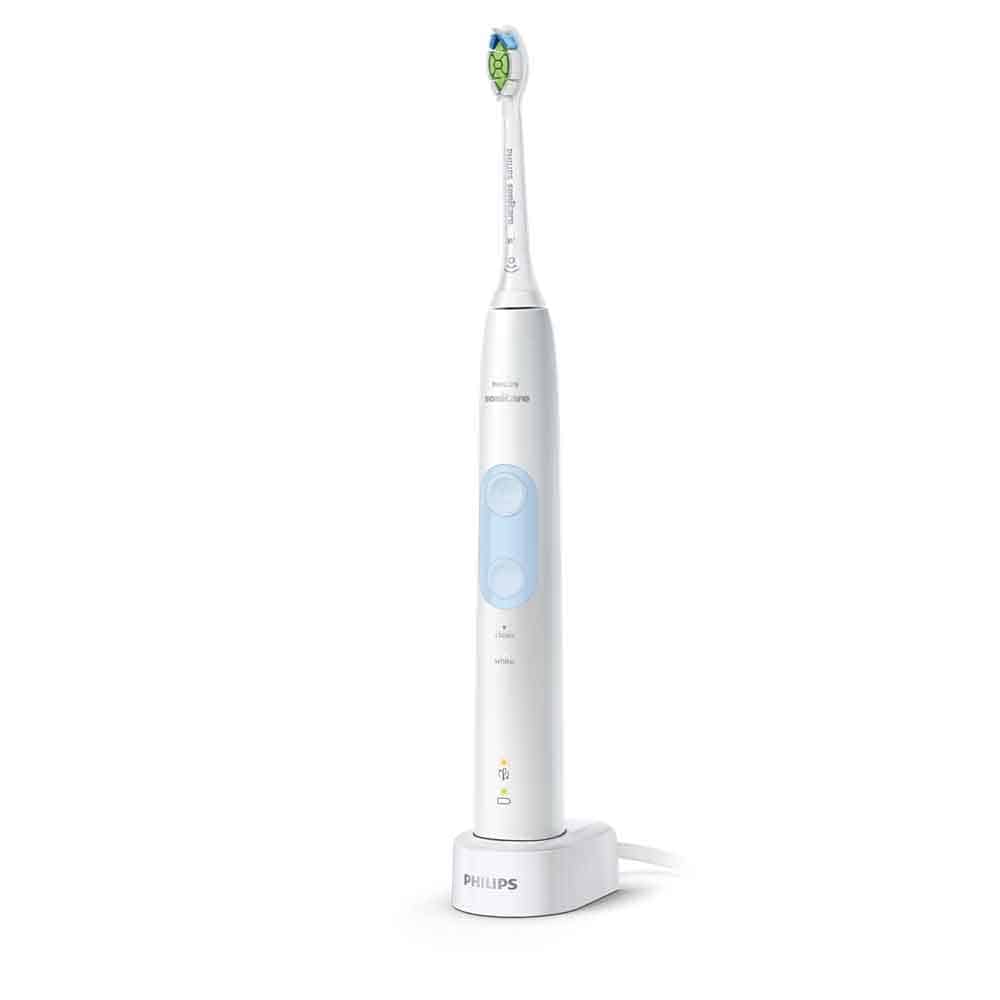
These stands are white in color to match the main color of the toothbrush handle.
A prong on the stand fits into the recess, on the base of the Optimal Clean 5000 series brush handle. When on the stand the toothbrush stands perfectly upright.
Once placed on the charging stand, provided it is connected to power, the charger will emit 2 short beeps to confirm that the handle is placed properly.
It can take up to 24 hours to charge the handle fully.
On the front of each brush handle is a battery/charging icon. This gives you some important feedback about the battery.
When on the charging stand, if it flashes it means it is charging.
When the handle is fully charged, the battery light, on the front of the handle, glows a solid green for 30 seconds and switches off.
In use, or when off the charging stand, this same LED will give some further feedback
- A solid green LED means a full battery.
- A flashing green LED means a medium battery.
- A flashing amber LED and three beeps mean a low battery.
- A flashing amber LED and five beeps mean no brushing sessions left, you need to charge the toothbrush.
A US power adapter is wired into the stand, but it does support 100-240v.
What this means is that you can actually travel to other countries, like those in Europe and use this charging stand. You will require a plug adapter only and not a voltage adapter.
Generally speaking, it is ok to leave the brush sat on the charging stand when not in use. It is perfectly fine to keep the battery topped up,
But, good practice is to let it run down a little and not constantly be fully charged. To avoid doing any potentially long term damage to the battery, keep it unplugged unless it needs charging.
Summary of battery life
Price & where to buy
I have included links to buying options here at the start of the review.
In the section below, I discuss the price more generally and in relation to similar products.
The suggested retail price of the HX6829/72 Optimal Clean from Sonicare is $119.99.
Whether it is worth this is ultimately personal opinion, but I have to say I was genuinely quite surprised by this price considering what you get in the box. I had expected it to be quite a bit higher.
The reason being is that the closest alternative model from Sonicare is the ProtectiveClean 5100.
The 5100 has a retail price of $100 and includes just 1 brush handle. Therefore it seems only logical that the 2 handles included with the Optimal Clean would cost a bit more.
The reality is that most retailers will sell the toothbrush a little below the retail price and the 5100 typically sells for $95, $5 less than retail.
Whilst it would of course be nice if the Optimal Clean fell below the $119.99 I think you can see how in all reality it is still a pretty reasonable price.
Because you get 2 handles, 2 charges and 2 travel cases, you can essentially split the price down the middle and call it $60 per brush.
The ProtectiveClean 4100 from Sonicare average selling price is $50 and that has only 1 cleaning mode and no travel case included.

To try and get a benchmark of costs, here at Electric Teeth we typically like to price each toothbrush over a 3 year period, to make it easier to compare with others. In almost all cases this is based on 1 brush handle.
Given that this is a dual handle package the most obvious thing to do is to split the price in half, so $60 per handle.
Each handle comes with a single brush head and there is just 1 spare one. For the purpose of this price comparison I will exclude that extra brush head.
Over 3 years, you will require 11 additional heads. Costing on average $10 each, this is an additional cost of $110. Add this to the $60 purchase price and you have a 3 year ownership cost of $170 per handle.
It is possible to get a deal on the brush heads from time to time and bring the cost down to around $8 per head, so $88 in total or $148 over 3 years.
In both instances, this works out cheaper than the ProtectiveClean 4100 and 5100.
All told, an excellent value toothbrush.
Please note that all prices quoted are approximates and will vary based on location, supplier and time of purchase. These figures were correct at the time of writing and should not be relied upon as hard fact, but used as a guide during your decision process.
Summary of price & where to buy
Reliability & long term use
Any electric toothbrush that is reviewed by Electric Teeth is assessed as best as possible to look for possible reliability and performance issues.
Not completed by any specialist equipment, it is done by eye and making comparison to the many other brushes we have used.
Our experience allows me to say that whilst there is always the potential for something to go wrong, (there are electrical circuits built-in) the build quality and performance I have experienced gives no cause for concern.
The brush feels solid and well built-in hand as is typical of a Sonicare product.
Added peace of mind comes from the 2 year manufacturer warranty, provided as standard when you buy the Optimal Clean 5000 series.
Conclusion
Whilst it is possible to share an electric toothbrush, it is often more convenient if each user has their own.
If you and your partner, the kids or even a close friend are in the market for a new electric toothbrush, the Optimal Clean is a great toothbrush to buy.
Not only does it clean the teeth well but the dual handle package represents excellent value.
Rarely do you get a travel case and charging stand included for each handle, but here you do.
Size guide
- Toothbrush height with head - 25cm / 9.8 inches
- Toothbrush height without head - 19cm / 7.5 inches
- Width - 2.8cm / 1.1 inches
- Depth/thickness - 3cm / 1.1 inches
- Weight with head - 130g / 4.6oz
- Weight without head - 125g/ 4.4oz
- Travel case size - 22cm / 8.7 inches (L) x 7.3cm / 2.9 inches (W) x 4cm / 1.6 inches (D)
- Travel case weight - 84g / 3oz (withouth brush) or 214g / 7.6oz (with brush)
- Package weight - 992g / 35oz
Noise
- 59dB
Country of manufacture
- China


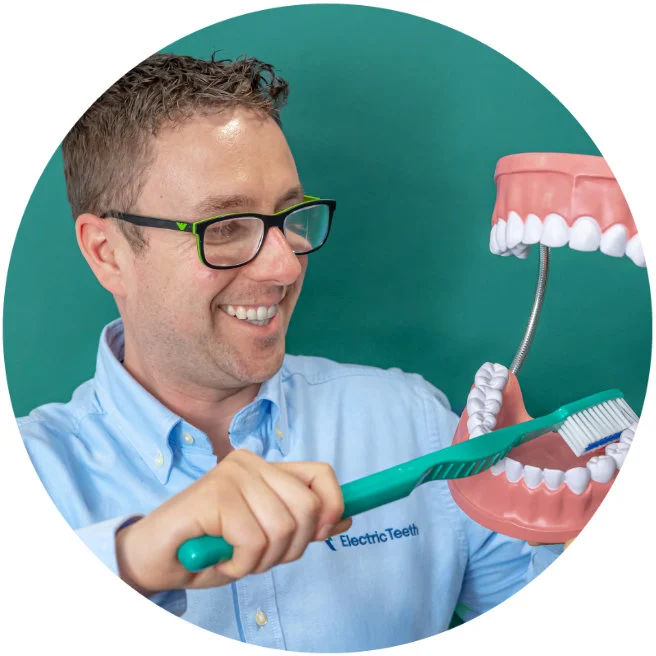
Has anybody tried charging the Optimal Clean in the glass based charger that comes with the diamond clean connected?
I have not tried this. I don't think it will work.
Can this been use for kids, 5 and 9y old?
It should be fine for the 9yr old. The brush head might be a little large for the 5yr old.
You could look to fit a kids brush head to the handle to help with the size issue.
You would need to be considerate as to whether the intensity of the brushing will be too much for the 5yr old. It might be fine, but monitor.
What is the difference between the soft and normal intensity settings on the sonicare, model hx6829/72?
Hi Tom. It is the power/number of brush strokes that differ.
What the exact number of movement differences are I don't know, Sonicare doesn't make such information public.
There is a bit more explanation of the different cleaning modes within our article, Sonicare brushing modes explained.